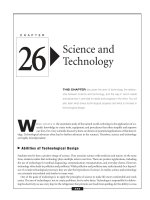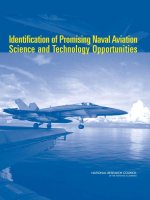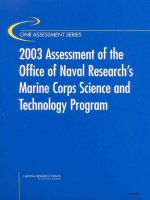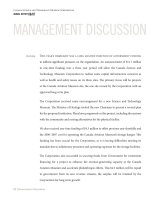Science and Technology
Bạn đang xem bản rút gọn của tài liệu. Xem và tải ngay bản đầy đủ của tài liệu tại đây (141.6 KB, 12 trang )
W
HILE SCIENCE IS
the systematic study of the natural world, technology is the application of sci-
entific knowledge to create tools, equipment, and procedures that often simplify and improve
our lives. For every scientific discovery, there are dozens of potential applications of that knowl-
edge. Technological advances often lead to further advances in the sciences. Therefore, science and technology
are highly interdependent.
Abilities of Technological Design
Students tend to have a positive image of science. They associate science with medicine and nature. At the same
time, students realize that technology plays multiple roles in our lives. There are positive applications, including
the use of technology for medical diagnosing, communication, transportation, and everyday chores. However,
technology often leads to pollution and problems. While pollution and problems may unfortunately be a byprod-
uct of certain technological processes, they are also the byproducts of science. In reality, science and technology
are extremely interrelated and similar in many ways.
One of the goals of technology is to apply the principles of science to make life more comfortable and work
easier. The aim of technology is not to create problems, but to solve them. Technology is responsible for deliver-
ing the electricity we use every day, for the refrigerator that prevents our food from spoiling, for the ability to cross
CHAPTER
Science and
Technology
THIS CHAPTER discusses the aims of technology, the relation-
ship between science and technology, and the way in which needs
and advances in one lead to needs and progress in the other. You will
also learn what drives technological progress and what is involved in
technological design.
26
245
an ocean on a plane within hours, for the calculator, the
ATM, and our connection to the Internet. Need we go
on? The printing press, toothpaste . . .
Science-Technology-Science
Relationship
Technology is applied science—science put to use.
While science is driven by a desire to understand the
world, technology is often driven by the desire to make
the world safer, more convenient, and more fun for peo-
ple. Science research that has immediate and wide appli-
cations tends to receive funding from the government
and private companies more easily than very abstract
research. Therefore, science that has technological
importance or potential is encouraged and driven by a
desire to produce and make a profit.
Technology is also science on a large scale. Running a
chemical reaction in a beaker in the lab is usually classi-
fied as science. Running the same reaction in a huge reac-
tor in a chemical plant is classified as technology. Science
and technology have a profound influence on each other,
and progress in one creates progress in the other.
Consider this example. Scientists figured out how
optical lenses work. The science was used to make a
microscope (technology). The microscope was used to
observe a cell (science). In order to isolate the genetic
material from this cell, an instrument had to be used
(technology). But that instrument operates according to
the laws of science.
Take another example. Scientists figured out the laws
of fluid mechanics. Engineers used these laws to design
airplanes. And now both scientists and engineers can fly
to science conferences around the world.
Optimization of Existing Products
and Processes
Technological inventions are often tools, instruments,
machines, or processes. Engineers recognize a need for
an invention and see it as a design opportunity. For
example, an engineer realizes that people are carrying
too many electronic devices—a telephone, a digital plan-
ner, a watch, a calculator, a laptop—so why not create
one device that can be used to accomplish what all of the
limited electronic devices do?
Consider how the need for computers arose. Scien-
tists were tired of performing slow, repetitive calcula-
tions. It took too long, and progress was limited. So,
computers were designed to perform these long, repetitive
calculations. The first computers were massive and
required the use of special punch cards. But with the
advancement of technology, they became small enough to
be portable. Improving existing designs or processes is
another goal of technology.
Alternative Solutions, Models, and
Computer Design
Just as there are many ways to get from one place to
another, there are sometimes many solutions to an engi-
neering problem. Because of that, engineers need to care-
fully evaluate several different designs and choose
between alternative solutions. In addition to performing
calculations, engineers build models of their designs or
simulate a process using specialized computer programs.
For example, a program called CAD (Computer
Aided Design) can be used to analyze harmful emissions
into the atmosphere from vehicles (cars, trucks, and
buses). Based on computer simulations, engineers are
able to predict whether adding a lane of traffic would
increase emissions above levels determined to be safe by
environmental protection agencies.
Chemical processes can also be simulated using com-
puter programs. Chemists discover new reactions or
chemicals, but chemical engineers design a chemical
plant that will run that reaction. Designing chemi-
cal plants involves sizing reactors and figuring out the
amount of reactants needed, how quickly the reaction
will proceed, how the product should be stored, how the
waste should be managed, at what temperature the reac-
tion should be run, and how to control different aspects
of the process. It would be very time-consuming, expen-
sive, and tedious to make a physical model for hundreds
of different conditions. With computers, processes can
be simulated, and physical models can be built based on
the computer simulations that work best.
Design Considerations
Each technological design has to meet a number of
design criteria. The product or process should operate
smoothly, without breaking down. The demand for such
a product or process should be evaluated. The product or
process should be an improvement over other similar
products and processes. Improvement can be functional
(working better), economic (more profitable), or aes-
thetic (better looking, or taking up less space). Products
and processes can also be made safer for people to use or
run, and safer for the environment. All of these design
–
SCIENCE AND TECHNOLOGY
–
246
criteria need to be considered. Economics often limit the
implementation of an otherwise best design. For exam-
ple, the collection of solar energy is technologically pos-
sible and is good for the environment, but it is not widely
used because it is not economical yet. Cars that run solely
on electric power have been designed and built, but
again, economics prevents their production. Oil compa-
nies would lose profit if the use of electric cars became
widespread, and designs have been bought with the pur-
pose of preventing their manufacture.
Evaluating the Consequences
The consequences of a technology product or process
need to be evaluated by scientists and engineers, but also
by public policy makers and consumers. What kind of
short- and long-term effects does a technological
advance have on individuals, on the population, and on
the environment? You should be aware that technologi-
cal advances can have a variety of beneficial or harmful
consequences on the living standard, health, environ-
ment, and economy. You should also be able to state the
tradeoffs often involved in choosing a particular design
or adopting a particular public policy. For example, you
should be aware of the reasons for, and consequences of,
the one-child policy in China, and the different positions
in current debates such as the use of fetal tissue in stem
cell research, genetic engineering, recycling policy, and
other issues.
Communication
Communication is another component of technological
development. Engineers often need to convince their
superiors or the public of the advantages of their designs.
The communication involves stating the problem,
describing the process or design, and presenting the solu-
tion. This is done through publishing or presenting
reports, models, and diagrams and showing that a par-
ticular design has advantages over alternative designs.
Understandings about Science
and Technology
Scientists in different disciplines ask different questions
and sometimes use different methods of investigation.
Many science projects require the contributions of indi-
viduals from different disciplines, including engineering.
The Human Genome Project, designed to map the
human genome, involved thousands of researchers
worldwide and was the largest, most expensive project in
the history of biology. New disciplines of science, such as
geophysics and biochemistry, often emerge at the inter-
face of two older disciplines.
Technological knowledge is often not made public
because of patents and the financial potential of the idea
or invention. Similarly, it takes a while for a new drug to
reach the public because extensive testing and legal issues
are often involved.
–
SCIENCE AND TECHNOLOGY
–
247
S
OME PEOPLE MAY
think that science is best left to the scientists. But science is really every citizen’s
concern. Individuals and communities must decide which new research proposals to fund and
which new technologies to let into society. These decisions involve understanding the alternatives,
risks, costs, and benefits. By being informed and educated regarding these issues, we can better decide what kind
of advances and projects are beneficial. Students should understand the importance of asking:
■
What can happen?
■
What are the odds?
■
How do scientists and engineers know what will happen?
Personal and Community Health
As human beings, we function better when we are healthy and well. Malnutrition and poor hygiene are factors
that can affect health and the body’s ability to function properly. An unhealthy body is prone to diseases and other
hazards found in the environment. There are two kinds of diseases: infectious and noninfectious.
CHAPTER
Personal
and Social
Perspectives
in Science
SCIENCE DOES not happen in a vacuum. Scientific advances
directly affect technology, which impacts politics and economics
around the world. This chapter will discuss current personal and social
concerns in the sciences, including personal and public health, pop-
ulation growth, use of natural resources, and environmental protection.
27
249









